Eubrontes

Eubrontes (Hitchcock, 1845) is the name of fossilised dinosaur footprints dating from the Late Triassic and Early Jurassic. They have been identified from France, Poland, Slovakia, Italy, Spain, Sweden, Australia (Queensland) and the USA. It is a junior synonym of Grallator.[1]
Eubrontes is the name of the footprints, identified by their shape, and not of the genus or genera that made them, which is as yet unknown. They are most famous for their discovery in the Connecticut River Valley of Massachusetts in the early 19th century. They, among other footprints, were the first known dinosaur remains to be discovered in North America, though they were initially thought to have been made by large birds by Edward Hitchcock, a professor of Amherst College. (He originally assigned them to ichnotaxon Ornithichnites in 1836, then Ornithoidichnites in 1841, before coining Eubrontes in 1845.) Another major find occurred at Rocky Hill, Connecticut in 1966. Nearly 600 prints are preserved there in an area now designated Dinosaur State Park.

In early 1970s, a fiberglass cast of an Eubrontes giganteus footprint was made by Paul E. Olsen, then 14 years old, and his friend Tony Lessa. On June 29, 1972, it was sent by Olsen and Lessa to President Richard Nixon to get his support for registering the Riker Hill Fossil Site in Roseland, New Jersey as a National Natural Landmark.[2]
A typical Eubrontes print is from 25–50 cm long, with three toes that terminate in sharp claws. It belongs to a biped that must have been over one metre high at the hip and from 5–6 metres long. E. Colbert and others supposed that a large heavy carnivore like Teratosaurus (then considered to be a dinosaur) made the track, but a possible candidate is Dilophosaurus, a large theropod related to Coelophysis, or a close relative. However no Dilophosaurus fossil material is associated with Eubrontes tracks.
Eubrontes is the state fossil of Connecticut. The type species is Eubrontes giganteus. The French footprint has been called Eubrontes veillonensis. The name means 'true thunder,' probably referring to the supposed weight of the animal impacting on the ground.
A trackway attributed to the ichnogenus Eubrontes had a missing second digit on the right foot. The animal could have either lost the toe due to injury or it was malformed.[3]
See also
- Connecticut River Valley trackways
- List of Australian and Antarctic dinosaurs
- Grallator
- Anomoepus
- Dilophosaurus
- Edward Hitchcock
Notes
- ^ Attention: This template ({{cite doi}}) is deprecated. To cite the publication identified by doi:10.1080/10420940390256249, please use {{cite journal}} (if it was published in a bona fide academic journal, otherwise {{cite report}} with
|doi=10.1080/10420940390256249instead. - ^ Foot Forward. State of The Planet Blogs of The Earth Institute at Columbia University. March 11, 2009 - accessed on March 27, 2009
- ^ Molnar, R. E., 2001, Theropod paleopathology: a literature survey: In: Mesozoic Vertebrate Life, edited by Tanke, D. H., and Carpenter, K., Indiana University Press, p. 337-363.
References
- Colbert, E., Dinosaurs, Hutchinson & Co, 1962
- "Dino Land State Fossils: Eubrontes of Connecticut". Archived from the original on 2009-10-27.
- Queensland Dinosaur Trackways home.alphalink.com.au/dannj/larkqury.htm
